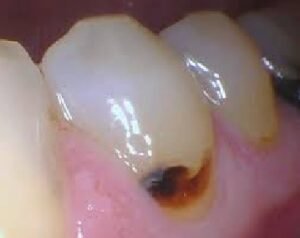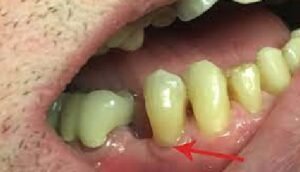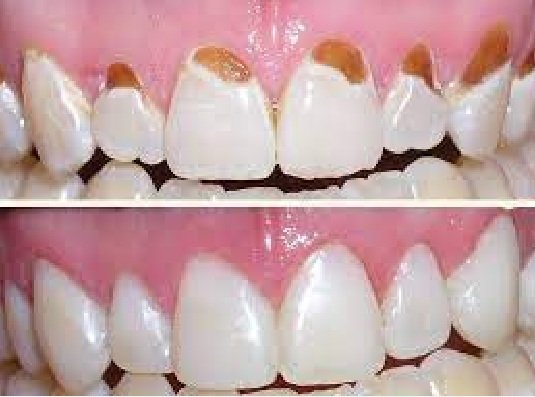Tooth decay at gum line pictures:



ooth decay is a common dental problem that can affect various parts of a tooth, including the gum line. Decay at the gum line, also known as root caries or cervical caries, occurs when the tooth’s roots near the gum tissue become damaged and develop cavities. In this comprehensive guide, we will explore tooth decay at the gum line, including its causes, symptoms, risks, prevention, treatment, and home remedies. We’ll cover the following subheadings to provide valuable insights into this dental issue:
What Is Tooth Decay at the Gum Line?
Tooth decay at the gum line refers to the formation of cavities or caries on the exposed roots of a tooth near the gum tissue. Unlike cavities on the crown (top) of a tooth, which are typically caused by acids from bacteria breaking down sugars, root caries are primarily caused by factors related to gum recession, aging, and root exposure. The roots of teeth are covered by a softer material called cementum, which is more susceptible to decay compared to the enamel covering the crown.
What Causes Tooth Decay at the Gum Line?
Several factors contribute to the development of tooth decay at the gum line:
1. Gum Recession:
When the gum tissue recedes or pulls away from the tooth, it exposes the sensitive root surface. Gum recession can be caused by aging, aggressive tooth brushing, gum disease, or other factors.
2. Poor Oral Hygiene:
Inadequate brushing and flossing can lead to the accumulation of plaque, a sticky film of bacteria, on the tooth’s surface, including the roots. This plaque can eventually harden into tartar, providing a breeding ground for cavity-causing bacteria.
3. Diet and Sugar Consumption:
Consuming a diet high in sugars and carbohydrates can feed bacteria in the mouth, leading to acid production and enamel erosion. These acids can affect the roots when gum recession is present.
4. Dry Mouth:
A lack of saliva (dry mouth) can contribute to tooth decay as saliva helps neutralize acids and cleanse the mouth. Medications, medical conditions, and aging can all cause dry mouth.
5. Tobacco and Smoking:
Tobacco use and smoking can increase the risk of gum disease and gum recession, making the roots more susceptible to decay.
Symptoms of Tooth Decay at the Gum Line:
Recognizing the signs and symptoms of tooth decay at the gum line is crucial for early intervention. Common symptoms may include:
- Tooth Sensitivity: You may experience increased sensitivity to hot, cold, sweet, or acidic foods and beverages, especially at the gum line.
- Visible Cavity: In some cases, you may notice a visible cavity or hole near the gum line when examining your teeth or feeling it with your tongue.
- Discoloration: The affected area may appear dark brown, black, or discolored compared to the surrounding tooth structure.
- Pain or Discomfort: As the decay progresses, you may experience pain or discomfort, especially when eating or drinking.
- Gum Recession: If gum recession is present, it can be an early sign that the roots are exposed and at risk of decay.
- Bad Breath: In some cases, tooth decay at the gum line can contribute to bad breath (halitosis).
Risks of Tooth Decay at the Gum Line:
Ignoring or neglecting tooth decay at the gum line can lead to several risks and complications:
1. Tooth Loss:
Advanced decay can weaken the tooth structure, leading to tooth loss if left untreated.
2. Infection:
Decayed roots can become infected, causing pain, swelling, and the need for more invasive dental treatments.
3. Discomfort and Sensitivity:
Tooth sensitivity and discomfort can interfere with your daily life, making it challenging to enjoy hot or cold foods.
4. Aesthetic Concerns:
Visible cavities or discoloration near the gum line can affect the appearance of your smile.
5. Compromised Chewing Function:
Damage to the roots can affect your ability to chew food effectively.
How to Prevent Tooth Decay at the Gum Line:
Preventing tooth decay at the gum line involves a combination of good oral hygiene practices and lifestyle choices:
1. Maintain Proper Oral Hygiene:
Brush your teeth gently with a soft-bristle toothbrush at least twice a day. Use dental floss or an interdental brush to clean between your teeth and along the gum line.
2. Use Fluoride Toothpaste:
Choose a fluoride toothpaste to strengthen tooth enamel and protect against decay.
3. Limit Sugar and Acidic Foods:
Reduce your consumption of sugary and acidic foods and beverages. When you do consume them, rinse your mouth with water afterward.
4. Address Gum Disease:
If you have gum disease or gum recession, seek treatment from a dentist or periodontist. Treating gum disease can help prevent further gum recession and root decay.
5. Stay Hydrated:
Drink plenty of water throughout the day to help maintain saliva production, which aids in neutralizing acids and cleansing the mouth.
6. Quit Smoking:
If you smoke or use tobacco products, consider quitting to reduce the risk of gum disease and gum recession.
7. Regular Dental Checkups:
Visit your dentist for regular checkups and cleanings. Dental professionals can detect and address tooth decay and other oral health issues early.
How to Treat Tooth Decay at the Gum Line:
Treating tooth decay at the gum line typically involves dental procedures to remove the decayed portion and restore the tooth. Common treatment options include:
1. Dental Fillings:
For early-stage decay, a dentist can remove the decayed portion and fill the cavity with a dental filling. Fillings can be made from materials like composite resin, amalgam, or glass ionomer.
2. Dental Crowns:
In cases of more extensive decay or when the tooth structure is compromised, a dental crown may be recommended. A crown covers the entire tooth, providing strength and protection.
3. Root Canal Therapy:
When decay reaches the inner pulp of the tooth and causes infection, a root canal procedure may be necessary to remove the infected tissue, disinfect the tooth, and seal it.
4. Periodontal Treatment:
If gum disease is contributing to gum recession and root decay, periodontal treatment may be required to address the underlying gum issues.
Home remedies for tooth decay at the gum line:
1. Saltwater Rinse
A saltwater rinse is a simple and effective way to soothe gum discomfort and reduce inflammation. To create a saltwater rinse:
- Mix half a teaspoon of salt in a glass of warm water.
- Swish the solution around your mouth for 30 seconds, focusing on the affected area.
- Spit out the mixture and repeat a few times a day, especially after meals.
2. Fluoride Mouthwash
Using a fluoride mouthwash can help strengthen tooth enamel and make it more resistant to decay. Look for an over-the-counter fluoride mouthwash and use it according to the manufacturer’s instructions. Rinse your mouth thoroughly for the recommended duration.
3. Clove Oil
Clove oil has natural analgesic and anti-inflammatory properties, making it a popular remedy for tooth pain. To use clove oil:
- Soak a cotton ball or swab in a small amount of clove oil.
- Gently apply the soaked cotton to the affected area, taking care not to swallow the oil.
- Leave it in place for a few minutes or until you experience relief.
- Spit out any excess oil.
Remember that clove oil is potent, so use it sparingly and avoid direct contact with your tongue and gums.
4. Cold Compress
If you’re experiencing gum swelling or discomfort, a cold compress can help reduce inflammation and numb the area. Here’s how to use a cold compress:
- Wrap a few ice cubes in a clean cloth or place them in a plastic bag.
- Apply the compress to the outside of your cheek, directly over the affected area.
- Hold it in place for 15-20 minutes, then remove it for a break.
- Repeat as needed to reduce swelling and relieve pain.
5. Maintain Excellent Oral Hygiene
While not a “home remedy” in the traditional sense, maintaining exceptional oral hygiene is critical in preventing further decay and promoting gum health. Be sure to:
- Brush your teeth gently with a soft-bristle toothbrush twice a day.
- Floss daily to remove plaque and food particles between your teeth.
- Rinse your mouth with an antimicrobial or fluoride mouthwash to reduce bacteria and strengthen enamel.
When to See a Dentist About Tooth Decay at the Gum Line:
While home remedies can offer temporary relief and support oral health, they are not a substitute for professional dental care. It’s essential to know when to seek the expertise of a dentist. Here are some indications that you should make an appointment with your dentist:
- Persistent Pain: If you experience persistent or severe pain at the gum line, it’s crucial to consult a dentist. Pain can be a sign of advanced decay or an underlying issue that requires professional evaluation.
- Visible Decay: If you can see visible cavities or discoloration near the gum line, it’s a clear indication that dental attention is needed. Decay left untreated can progress and lead to more significant problems.
- Gum Recession: If you notice gum recession, where your gums are pulling away from your teeth, it’s essential to address the issue promptly. Receding gums can expose the vulnerable root surfaces to decay.
- Persistent Bad Breath: Chronic bad breath, despite maintaining good oral hygiene, can be a sign of underlying dental issues, including tooth decay. A dentist can determine the cause and recommend appropriate treatment.
- Changes in Tooth Sensitivity: If you experience changes in tooth sensitivity, especially when eating or drinking, it could be related to tooth decay or other dental problems.
- Swelling or Pus: Swelling, discharge, or the presence of pus near the gum line is a clear sign of infection, which requires immediate dental attention.
- Previous Dental Issues: If you have a history of dental problems or have undergone dental treatments, regular checkups with your dentist are essential to monitor your oral health and address any emerging issues.
Remember that dental professionals are trained to diagnose and treat dental conditions effectively. Seeking prompt dental care ensures that tooth decay at the gum line is addressed early, preventing more extensive damage and potential tooth loss. Regular dental checkups are also vital for preventive care and maintaining optimal oral health.





